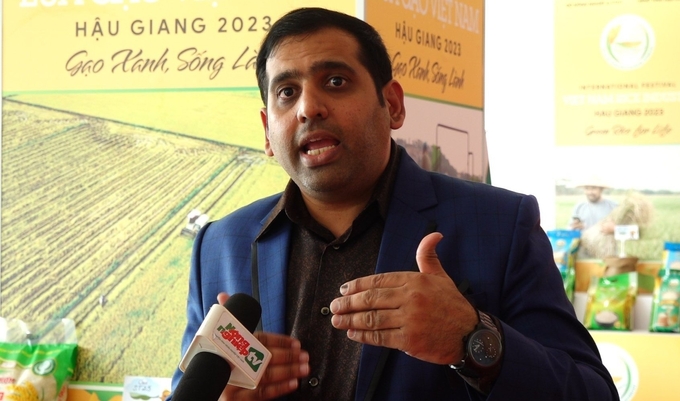November 25, 2025 | 18:14 GMT +7
November 25, 2025 | 18:14 GMT +7
Hotline: 0913.378.918
November 25, 2025 | 18:14 GMT +7
Hotline: 0913.378.918

Mr. Rakesh Hiranandani provided insights during an interview with the Vietnam Agriculture Newspaper. Photo: Thanh Thuy.
Prior to tightening rice exports, India once accounted for over 40% of the total global rice trade and supplied this commodity to more than 150 countries. One of the reasons behind this achievement lies in the adoption of technology.
India consistently ranks among the leaders in rice production and processing technology. Rakesh Hiranandani, representative of Suri Engineers – a major rice milling machine supplier in the country, mentioned that Indian export businesses prioritize the use of the latest technology for rice processing. This includes rice milling machines.
Rice milling machines are utilized to process raw paddy into processed rice. With the assistance of these machines, one can process 40-50 tons of rice per day. This helps reduce labor costs and yields higher profits for those in the industry.
"The post-harvest cleaning of rice is fully automated. Preliminary cleaning requires the removal of any impurities, such as dust, straw, sand, clay, or unevenly sized heavy particles. Subsequently, producers need to separate the husk to produce properly milled white rice, free of impurities and including minimal broken grains," stated Mr. Rakesh.
Rice processing is crucial for Indian consumers, where rice, much like in Vietnam and other Asian countries, is a staple food. Rice production businesses in India must ensure that after the rice milling process, the final product typically comprises 60-65% white rice, 8-10% bran, 15% husk, and 5-10% impurities such as stones and sand.

Rice milling is a key factor in enhancing the quality of rice.
Rice grains, before reaching the Indian market, usually undergo seven steps, including paddy cleaning, husking, residual paddy separation, whitening and polishing, rice sorting, color sorting, and finally, packaging. Each step is important, but without synchronized mechanization, producers are prone to errors, such as inadequate bran removal.
According to the Indian entrepreneur, many rice milling businesses focus on whitening machines, neglecting the connected bran processing system. A common mistake is improper bran removal in each cycle, which can exert uneven pressure on rice grains. This may lead to grains being trapped in the whitening machine for too long, resulting in friction, poor gloss, and excess heat, making the rice grains soft and prone to breakage.
Additionally, rice grains face the risk of quality deterioration if the drying technique is not correctly executed. "To prevent this, ensure even drying of paddy and monitor temperature and relative humidity to avoid over-drying or rehydration of the rice. The typical moisture content of paddy after rough drying or final drying should be 12-15%," continued Rakesh.
In a country where rice production is a major economic sector, the importance of rice milling machines in preserving rice quality and reducing damage is clearly defined. If milling is done to standard, the shelf life of rice can be significantly extended.
Through the International Rice Festival held in Hau Giang, Suri Engineers recognized the immense potential of the Vietnamese market. Rakesh admitted that Vietnam is on track to become the "rice bowl" of the global rice industry. The demand for mechanization and automation in the rice industry is thus considered to be in a period of significant growth.
"Some partners have introduced us to rice producers directly operating in Vietnam. The company has engaged in discussions and learned about the desire to seek smart production machinery that can best support rice farmers. These are the things Suri Engineers can provide," assured Rakesh.
In a report submitted to the National Assembly Standing Committee in August 2023, the Ministry of Agriculture and Rural Development stated that, with a very high safety margin, the amount of rice needed to ensure food security for 100 million people and other domestic consumption needs is approximately 29.5 million tons of paddy per year.
Vietnam has about 13.5 million tons of paddy (equivalent to 7-8 million tons of rice) for export. This figure is expected to remain stable until 2030, due to the plan to maintain 3.5 million hectares of rice fields. More than ever, the issue of improving the quality and value of rice grains is imperative.
Offering recommendations on this matter, Mr. Rakesh Hiranandani advises the Vietnamese rice industry to develop a large-scale model, integrating various technologies and modern machinery. With the support of the business community and international organizations, Vietnam should incorporate more machinery into production.
"I see Vietnam can become a strong food partner for any country globally. You have the capability to supply food and ensure food safety not only for the domestic population but also for the global market," emphasized Rakesh.
Translated by Dieu Linh

(VAN) Deputy Minister Nguyen Quoc Tri emphasized the determination to prevent violations at CoP20, sharing enforcement results and commitments to strengthen cooperation with the international community in the coming period.

(VAN) In addition to strengthening the relationship between schools and enterprises, the Aus4Skills project expands opportunities for female students and people with disabilities to work in the transport and logistics sector.

(VAN) Nghe An is preparing policy, technical, and resource steps to participate in the forest carbon credit market.
/2025/11/25/1648-2-110733_532.jpg)
(VAN) From 2011 to 2023, Ca Mau province lost approximately 6,200 ha of coastal land and protection forests due to erosion, threatening many residential areas, infrastructure facilities, and production zones.

(VAN) Quang Ngai holds strong potential for carbon credits but needs a clear legal and policy framework to secure sustainable revenue from this resource.

(VAN) With its diverse ecosystem, Phu Quoc National Park plays a vital role in environmental protection and biodiversity conservation and serves as the core zone of the Kien Giang World Biosphere Reserve.

(VAN) Cooperation activities under the Aus4Skills program focus on: logistics professional development, competency-based training and assessment (CBTA), leadership innovation, and digitalization.